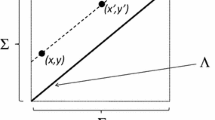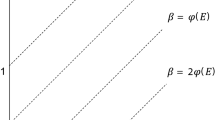Abstract
Preference reversals occur when different (but formally equivalent) elicitation methods reveal conflicting preferences over two alternatives. This paper shows that when people have fuzzy preferences, i.e. when they decide in a probabilistic manner, their observed decisions can generate systematic preference reversals. A simple model of probabilistic choice and valuation can account for a higher incidence of standard (nonstandard) preference reversals for certainty (probability) equivalents and it can also rationalize the existence of strong reversals. An important methodological contribution of the paper is a new definition of a probabilistic certainty/probability equivalent of a risky lottery.


Similar content being viewed by others
Notes
Linear function φ(.) is considered for analytical convenience. In this case, there is a closed-form solution to the integral on the left-hand side of inequality (7).
References
Allais, M. (1953). Le Comportement de l’Homme Rationnel devant le Risque: Critique des Postulats et Axiomes de l’Ecole Americaine. Econometrica, 21, 503–546.
Ballinger, T. P., & Wilcox, N. T. (1997). Decisions, error and heterogeneity. Economic Journal, 107, 1090–05.
Bateman, I., Day, B., Loomes, G., & Sugden, R. (2007). Can ranking techniques elicit robust values? Journal of Risk and Uncertainty, 34, 49–66.
Blavatskyy, P. R. (2006). Violations of betweenness or random errors? Economics Letters, 91, 34–38.
Blavatskyy, P. R. (2007). Stochastic expected utility theory. Journal of Risk and Uncertainty, 34, 259–286.
Blavatskyy, P. R. (2008). “Probabilistic choice and stochastic dominance,” IEW Working Paper 364, available at http://www.iew.uzh.ch/wp/iewwp364.pdf.
Blavatskyy, P. R., & Köhler, W. (2009). Range effects and lottery pricing. Experimental Economics, 12(3), 332–349.
Butler, J. D., & Loomes, G. C. (2007). Imprecision as an account of the preference reversal phenomenon. American Economic Review, 97(1), 277–297.
Cubitt, R. P., Munro, A., & Starmer, C. (2004). Testing explanations of preference reversal. Economic Journal, 114(497), 709–726.
Fishburn, P. (1978). A probabilistic expected utility theory of risky binary choices. International Economic Review, 19, 633–646.
Fishburn, P. (1988). Nonlinear preference and utility theory. Brighton: Wheatsheaf Books.
Gul, F., & Pesendorfer, W. (2006). Random expected utility. Econometrica, 71(1), 121–146.
Hey, J. (2001). Does repetition improve consistency? Experimental Economics, 4, 5–54.
Hey, J., & Orme, C. (1994). Investigating generalizations of expected utility theory using experimental data. Econometrica, 62, 1291–1326.
Lichtenstein, S., & Slovic, P. (1971). Reversals of preference between bids and choices in gambling decisions. Journal of Experimental Psychology, 89, 46–55.
Loomes, G., & Sugden, R. (1987). Some implications of more general form of regret theory. Journal of Economic Theory, 41(2), 270–287.
Loomes, G., & Sugden, R. (1995). Incorporating a stochastic element into decision theories. European Economic Review, 39, 641–648.
Loomes, G., & Sugden, R. (1998). Testing different stochastic specifications of risky choice. Economica, 65, 581–598.
MacCrimmon, K. & Smith, M. (1986). Imprecise equivalences: Preference reversals in money and probability. University of British Columbia Working Paper 1211.
Seidl, C. (2002). Preference reversal. Journal of Economic Surveys, 16, 621–655.
Schmidt, U., & Hey, J. D. (2004). Are preference reversals errors? An experimental investigation. Journal of Risk and Uncertainty, 29(3), 207–218.
Schmidt, U., Starmer, C., & Sugden, R. (2008). Third-generation prospect theory. Journal of Risk and Uncertainty, 36(3), 203–223.
Tversky, A., Slovic, P., & Kahneman, D. (1990). The causes of preference reversal. American Economic Review, 80(1), 204–217.
Author information
Authors and Affiliations
Corresponding author
Rights and permissions
About this article
Cite this article
Blavatskyy, P.R. Preference reversals and probabilistic decisions. J Risk Uncertain 39, 237–250 (2009). https://doi.org/10.1007/s11166-009-9078-9
Published:
Issue Date:
DOI: https://doi.org/10.1007/s11166-009-9078-9
Keywords
- Preference reversal
- Probabilistic choice
- Probabilistic valuation
- Certainty equivalent
- Probability equivalent




